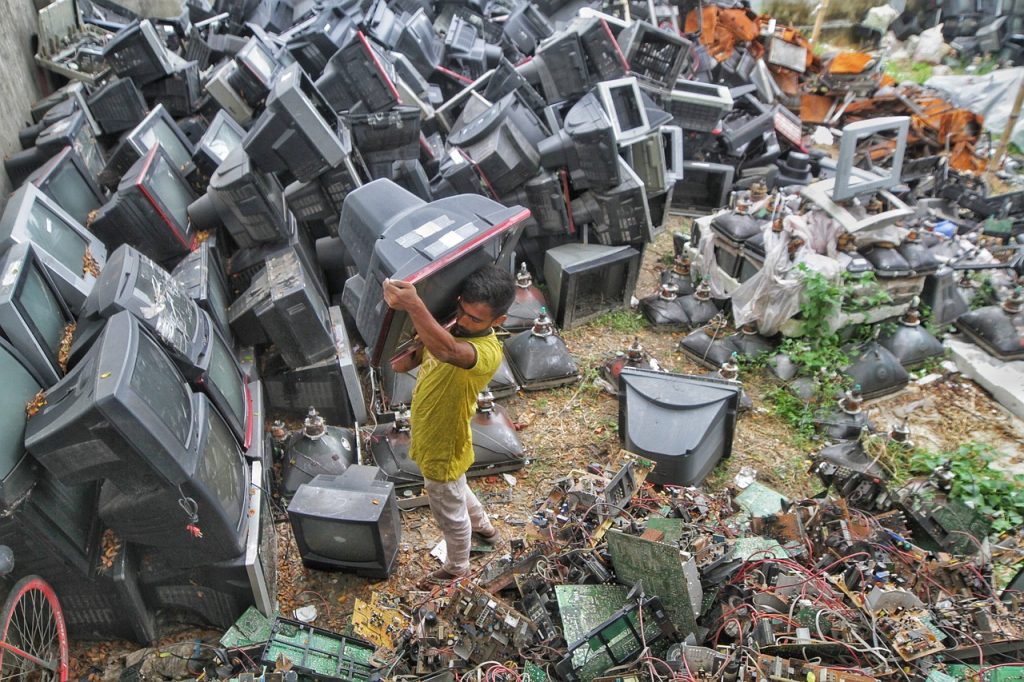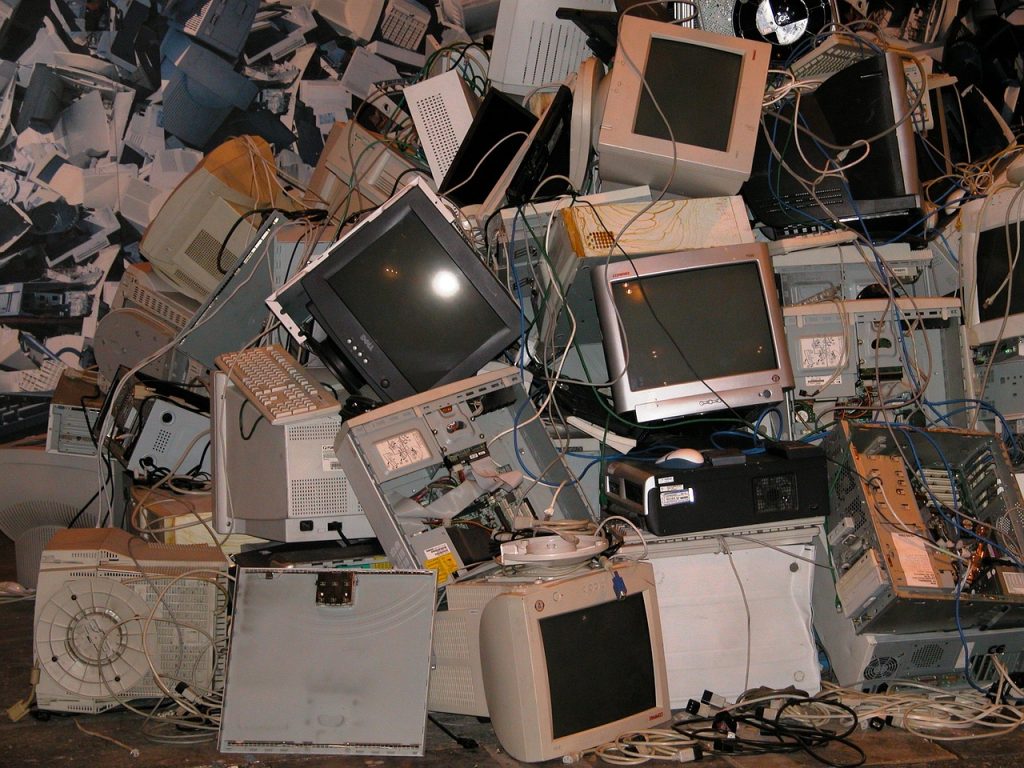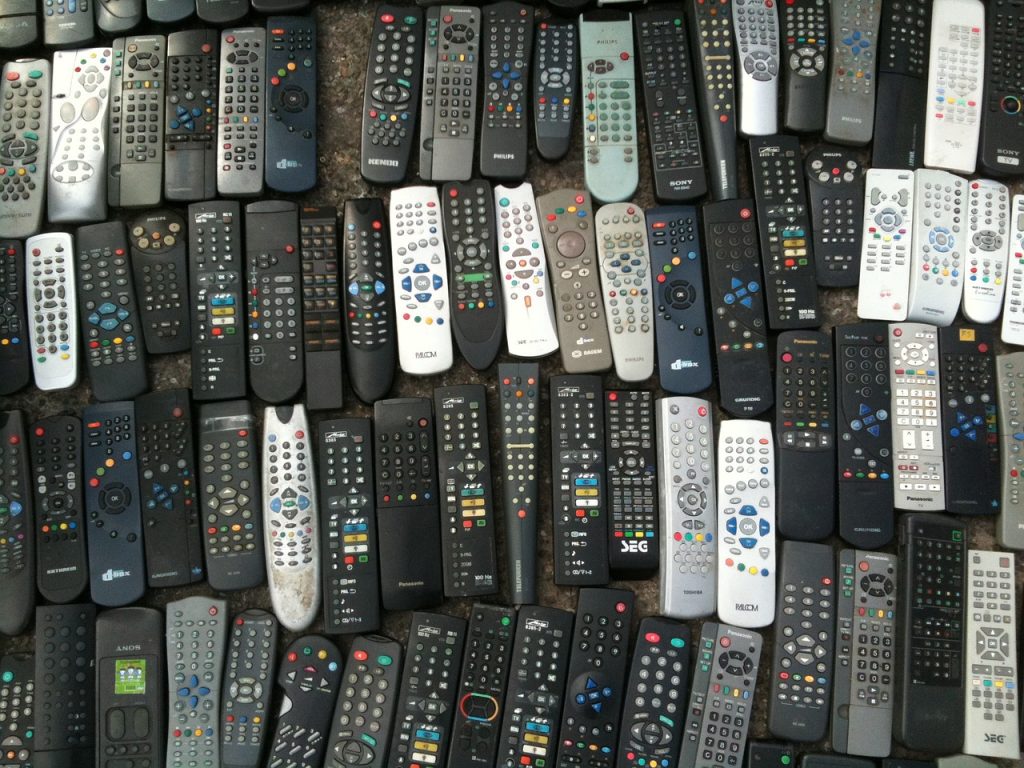In today’s rapidly advancing digital age, electronic devices have become integral to our daily lives. From smartphones and laptops to televisions and kitchen appliances, technology has undoubtedly made our lives more convenient. However, this technological revolution has given rise to a significant environmental challenge: electronic waste, or e-waste. As we continuously upgrade our devices to the latest models, the question of how to responsibly dispose of our old electronics has become increasingly pressing.
E-waste encompasses a broad range of discarded electronic devices that are no longer wanted, working, or in their prime. Unfortunately, the lifecycle of these gadgets is much shorter than their environmental impact. When improperly disposed of, e-waste can harm the environment and human health due to the toxic substances they contain, such as lead, mercury, and cadmium.
The issue of e-waste is not just about managing trash; it’s about recognizing the potential for recycling and reusing precious materials. Electronic waste management is an essential practice that involves the systematic collection, processing, and recycling or disposal of electronic devices. Effective e-waste management can conserve natural resources, reduce pollution, save energy, and reduce the greenhouse gas emissions that contribute to global warming.
Understanding E-Waste

E-waste, or electronic waste, refers to discarded electrical or electronic devices. Used electronics that are destined for refurbishment, reuse, resale, salvage recycling through material recovery, or disposal are also considered e-waste. Informal processing of e-waste in developing countries can lead to adverse human health effects and environmental pollution.
What Constitutes E-Waste?
E-waste encompasses a wide array of electronic devices that have reached the end of their useful life, from common household items to sophisticated business equipment. This includes:
- Consumer Electronics: Smartphones, tablets, laptops, desktop computers, monitors, TVs, and game consoles.
- Home Appliances: Refrigerators, washing machines, dryers, microwaves, electric cookers, and vacuum cleaners.
- Office Equipment: Printers, copiers, fax machines, and telephones.
- Entertainment Devices: DVD players, stereos, and electronic musical instruments.
- Personal Gadgets: Digital cameras, wearables (like smartwatches), and electronic toys.
As technology evolves, the list of items classified as e-waste continues to grow, encompassing anything electronic.
The Global Impact of E-Waste
The production of e-waste is a growing global issue, with millions of tonnes generated annually. Here are some critical statistics highlighting the environmental impact of e-waste:
- Rapid Growth: The Global E-waste Monitor reports that the world generated approximately 53.6 million metric tonnes (Mt) of e-waste in 2019, a figure expected to grow to 74 Mt by 2030, making e-waste the world’s fastest-growing domestic waste stream.
- Low Recycling Rates: Only about 20% of global e-waste is formally recycled, with the rest often dumped in landfills or informally recycled, leading to significant environmental and health hazards.
- Resource Loss: E-waste contains valuable materials such as gold, silver, copper, platinum, and critical raw materials like palladium and cobalt. The UN estimates that the raw materials in yearly e-waste are worth over $55 billion.
- Environmental and Health Risks: Improper e-waste disposal and processing lead to toxic substances leaching into the soil and water, causing pollution and health problems in communities, especially in developing countries where informal recycling markets thrive.
Benefits of Recycling Electronics
Recycling electronics has numerous benefits, addressing both environmental concerns and contributing to economic growth. Here are some of the key advantages:
- Conservation of Resources: Recycling recovers valuable materials from old electronics that can be used to make new products, reducing the need to extract fresh raw materials from the earth.
- Reduction in Pollution: Proper e-waste recycling helps prevent toxic materials from causing air and water pollution. It also reduces greenhouse gas emissions compared to manufacturing from virgin materials.
- Economic Benefits: E-waste recycling creates jobs in the recycling industry and can generate significant economic value from recovered materials. It also saves costs associated with the extraction and processing of raw materials.
- Data Security: Recycling through reputable programs ensures that personal data on electronic devices is securely destroyed, protecting against data breaches.
Understanding the components of e-waste, acknowledging its global impact, and recognizing the benefits of recycling are crucial steps toward mitigating the environmental and health risks associated with electronic waste. By promoting responsible e-waste management practices, we can conserve natural resources, protect ecosystems and human health, and support sustainable development.
How to Recycle Electronics

Recycling electronics is a crucial step in mitigating the environmental impact of e-waste. However, the process involves more than just dropping off old electronics at a recycling center. Proper preparation and choosing the right recycling options are essential for effective e-waste management. Here’s how you can ensure your electronics are recycled responsibly.
Preparing Your Electronics for Recycling
Before you recycle your electronic devices, it’s important to prepare them properly to ensure your data is protected and the device is ready for recycling. Follow these steps:
- Backup Your Data: Ensure all important files, photos, and contacts are backed up on another device or cloud storage. This step is crucial for preserving your information before you wipe the device.
- Log Out and Erase Data: Log out of all accounts, including email and social media. Perform a factory reset to erase all data from the device. Consult the device’s manual or manufacturer’s website for instructions on how to do this safely.
- Remove Batteries and SIM Cards: If possible, remove any batteries, SIM cards, or external storage devices. Batteries, in particular, may need to be recycled separately due to their potential environmental hazard.
- Clean the Device: Gently clean the device to remove any dirt or residue. This step is more about courtesy and potentially aiding in the device’s refurbishment or resale.
Finding the Right Recycling Facility
Not all recycling centers are equipped to handle e-waste, and choosing a certified facility ensures that your electronics are recycled responsibly. Here’s how to find the right facility:
- Look for Certifications: Search for facilities that are certified under e-Stewards or R2 standards. These certifications indicate that the facility follows strict environmental and safety guidelines in the recycling process.
- Use Official Resources: Visit websites like Earth911.com or the official website of your local environmental protection agency to find accredited e-waste recycling centers in your area.
- Check with Local Authorities: Some local governments offer e-waste recycling programs or can direct you to certified recycling facilities.
Manufacturer and Retailer Take-Back Programs
Many electronics manufacturers and retailers offer take-back or trade-in programs, providing an easy and responsible way to recycle old electronics. These programs often offer incentives for recycling and ensure that the devices are either refurbished, resold, or recycled responsibly.
- Manufacturer Programs: Brands like Apple, Samsung, and Dell have programs that allow you to return old products either in-store or by mail for recycling or trade-in credit.
- Retailer Initiatives: Retailers such as Best Buy, Staples, and Office Depot offer recycling drop-off services for a wide range of electronic devices, regardless of where they were purchased.
- Benefits: These programs often provide certain benefits, such as discounts on future purchases or gift cards, as an incentive to recycle through their schemes.
By preparing your electronics for recycling, choosing the right facility, and taking advantage of manufacturer and retailer take-back programs, you can ensure that your e-waste is handled in an environmentally responsible manner. This not only helps reduce the environmental impact of e-waste but also contributes to the circular economy, promoting the reuse and recycling of valuable materials.
Challenges in Electronics Recycling

Recycling electronics is a critical step towards mitigating the environmental impact of e-waste. However, the process is fraught with technical, logistical, and security challenges that can complicate efforts to recycle e-waste effectively and safely. Understanding these challenges is essential for developing strategies to overcome them.
The Complexities of E-Waste Recycling
Technical Challenges:
- Diverse Materials: Electronic devices are made from a complex mix of materials, including metals, plastics, and glass, some of which require specialized processes to recycle. Separating these materials without contaminating them or losing valuable components is technically challenging.
- Hazardous Substances: E-waste contains hazardous substances like lead, mercury, and cadmium, which pose health risks to workers and require careful handling and disposal to prevent environmental contamination.
- Rapid Technological Advancements: The fast pace of technological innovation means that devices quickly become obsolete, and recycling technologies must continually adapt to handle new types of e-waste.
Logistical Challenges:
- Collection and Transportation: Efficiently collecting and transporting e-waste from various sources to recycling facilities is logistically complex and costly. Ensuring that this process is environmentally friendly adds another layer of difficulty.
- Global Disparities: The export of e-waste from developed to developing countries, where environmental regulations may be less strict, raises ethical and environmental concerns. These disparities complicate the global effort to manage e-waste sustainably.
Addressing the Issue of Data Security
One of the significant concerns with recycling electronics is ensuring the secure deletion of personal data from devices. The fear of data breaches or identity theft can deter individuals and businesses from recycling their electronics. Here are strategies to address data security:
- Data Wiping: Before recycling, devices should undergo a thorough data wiping process using software that complies with international data destruction standards. This software can overwrite data multiple times, making it irretrievable.
- Physical Destruction: For devices that cannot be wiped clean through software, physical destruction of the data storage components (like hard drives and memory cards) is necessary. This should be done in a manner that makes data recovery impossible but allows for the recycling of other parts of the device.
- Secure Recycling Practices: Choose recycling facilities that adhere to certified data destruction standards and conduct regular audits of their data security practices. Certifications like e-Stewards and R2 include data security as part of their criteria.
- Transparency and Documentation: Reputable recyclers should provide documentation certifying that data was destroyed according to industry standards. This transparency helps build trust and ensures accountability.
The challenges in electronics recycling are significant but not insurmountable. Addressing the technical and logistical complexities, along with implementing strict data security measures, is essential for building an efficient, secure, and environmentally responsible e-waste recycling system. By overcoming these challenges, we can make significant strides toward reducing the environmental impact of electronic waste and promoting a more sustainable future.
Innovations in E-Waste Management

The escalating issue of electronic waste has sparked a wave of innovation within the recycling industry. As we grapple with the challenges of e-waste, cutting-edge technologies and inspiring success stories offer hope for a more sustainable future in e-waste management.
Cutting-Edge Recycling Technologies
Innovations in recycling technologies are crucial for improving the efficiency and effectiveness of e-waste recycling processes. These advancements not only enhance our ability to recover valuable materials but also reduce environmental harm. Here are some of the pioneering technologies being developed:
- Advanced Material Recovery: New techniques in material recovery, such as hydrometallurgical and biometallurgical processes, use liquid solutions and biological agents, respectively, to extract precious metals from e-waste more efficiently and with less environmental impact than traditional methods.
- Robotics and Automation: Automated sorting systems and robots equipped with artificial intelligence (AI) can identify and separate different types of electronic waste at a faster rate and with greater accuracy than manual sorting. This technology reduces labor costs and increases the volume of e-waste that can be processed.
- Eco-friendly Disassembly: Innovations in disassembly techniques aim to make it easier to take apart electronic devices and recover reusable components. These methods reduce the need to shred and grind e-waste, preserving the quality of materials for reuse.
- Blockchain for E-Waste Management: Blockchain technology is being explored for its potential to track the lifecycle of electronic products. This could improve supply chain transparency, ensure responsible recycling practices, and prevent illegal dumping of e-waste.
Success Stories in E-Waste Recycling
Several countries and companies have made significant strides in e-waste recycling, setting benchmarks for others to follow. These success stories demonstrate the potential for effective e-waste management strategies:
- Rwanda’s National E-Waste Recycling Facility: Rwanda established its first national e-waste recycling facility, positioning itself as a leader in e-waste management in Africa. The facility provides a sustainable solution for handling the country’s electronic waste, creating jobs, and recovering valuable materials.
- The European Union’s WEEE Directive: The EU’s Waste Electrical and Electronic Equipment (WEEE) Directive has significantly increased e-waste collection and recycling rates across member states. The directive sets collection, recycling, and recovery targets for all types of electrical goods, serving as a model for regulatory approaches to e-waste.
- Apple’s Recycling Robot, Daisy: Apple introduced Daisy, a recycling robot capable of disassembling iPhones to recover valuable materials. Daisy represents a leap forward in automated e-waste recycling, showcasing how companies can take responsibility for their products throughout their lifecycle.
These innovations and success stories in e-waste management illustrate the potential for significant improvements in how we handle electronic waste. By leveraging new technologies and learning from effective strategies implemented around the world, we can enhance e-waste recycling efforts, reduce environmental impact, and move closer to a circular economy for electronics.
How You Can Make a Difference

The challenge of electronic waste is daunting, but individual actions can collectively make a significant impact. By adopting more sustainable habits concerning electronics usage and disposal, consumers can contribute to reducing e-waste and promoting a healthier environment. Here’s how you can make a difference.
Simple Steps to Reduce E-Waste
Minimizing e-waste begins with the decisions we make as consumers, from purchasing to disposal. Here are practical tips to help reduce your electronic waste footprint:
- Buy Wisely: Consider the necessity before purchasing new electronics. Opt for devices with a longer lifespan or those that offer easier repairability.
- Extend Device Lifespan: Regular maintenance and updates can extend the life of your devices. Installing new software, replacing batteries, or upgrading certain components can rejuvenate an old device.
- Donate or Sell: If you have electronics that are still functional but no longer needed, consider donating them to schools, non-profits, or individuals in need. Alternatively, selling them can give them a new life elsewhere.
- Recycle Properly: When a device has reached the end of its life, ensure it is recycled at a certified e-waste recycling center. This step ensures that valuable materials are recovered, and harmful substances are disposed of responsibly.
- Support Eco-friendly Brands: Patronize companies that have robust recycling programs, use recycled materials in their products, and design products that are energy-efficient and easier to repair.
Advocating for Sustainable Electronics Usage
Beyond individual actions, advocating for broader systemic changes can amplify the impact on e-waste reduction. Here’s how you can advocate for sustainable electronics usage:
- Support Right to Repair Legislation: Advocate for laws that require manufacturers to make their products more repairable and to provide consumers and third-party repair shops with access to parts, tools, and service information. This can extend the life of electronics and reduce waste.
- Engage with Product Standards: Support and demand higher sustainability standards for electronics. This includes energy efficiency, the use of recycled materials, and product design that facilitates recycling.
- Educate Others: Share information about the impact of e-waste and how to manage it responsibly. Education can lead to collective action and greater pressure on manufacturers and policymakers to prioritize sustainability.
- Participate in Take-Back Programs: Encourage the use of manufacturer and retailer take-back programs, which ensure responsible recycling and sometimes offer incentives for returning old electronics.
- Advocate for Corporate Responsibility: Support campaigns that call on electronics manufacturers to reduce their environmental footprint, such as through greener manufacturing processes and more sustainable supply chains.
By taking these simple steps and advocating for sustainable electronics usage, individuals can contribute to a significant reduction in e-waste. Each action, no matter how small, helps promote a more sustainable approach to electronics, benefiting both the environment and society.
